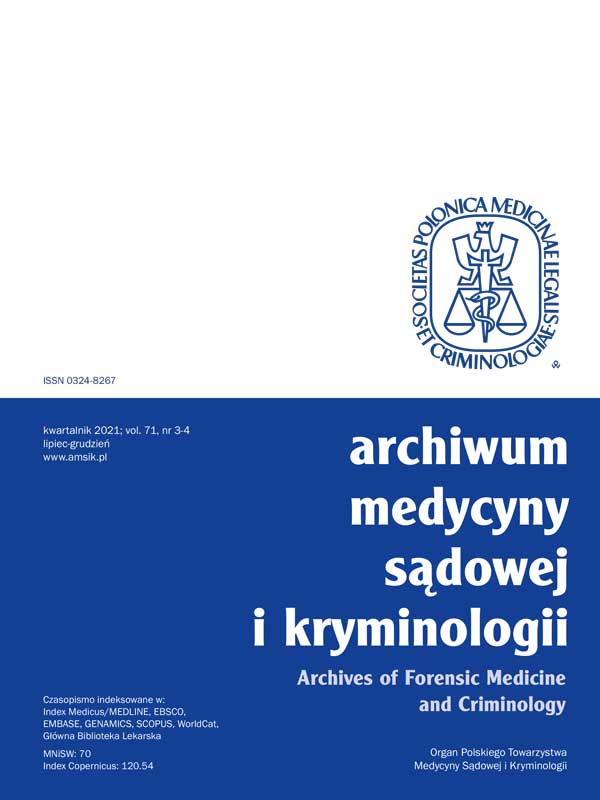Zróżnicowanie postrzałów z myśliwskiej broni o lufach gwintowanych w zależności od rodzaju pocisków – opiniowanie sądowe
Differentiation of shots from hunting weapons with threaded barrels depending on the type of projectiles – forensic opinions
Author(s): Marian Flis, Aleksandra FlisSubject(s): Law, Constitution, Jurisprudence, Criminal Law, Criminology
Published by: Wydawnictwo Uniwersytetu Jagiellońskiego
Keywords: shooting; firearms; half-jacket ammunition; full-jacket ammunition; forensic opinion
Summary/Abstract: Cel pracy: W pracy przedstawiono podstawowe zasady opiniowania sądowego w sytuacjach postrzeleń ludzi lub zwierząt na polowaniach z broni długiej o lufach gwintowanych, w tym postrzeleń ze skutkiem śmiertelnym. Materiał i metody: Opinie takie wydawane są w oparciu o zgromadzony materiał dowodowy oraz wiedzę biegłego z zakresu broni i amunicji, balistyki jak również z zakresu medycyny anatomopatologicznej. Wyniki: Tego rodzaju kompleksowe analizy pozwalają na wydanie szczegółowej, a zarazem precyzyjnej opinii jako szczególnego środka dowodowego, mającego najistotniejsze znaczenie w przebiegu całego postępowania procesowego. Dlatego też niezmiernie ważnym jest właściwe zabezpieczenie materiału dowodowego w postaci pocisku lub jego fragmentów i konfrontacji tych elementów z oceną rany postrzałowej, a przede wszystkim kształtu i rozmiaru kanału postrzałowego oraz chwilowej jamy postrzałowej. Tego rodzaju postępowania są dość skomplikowane, gdyż wymagają od biegłego szerokiego spektrum wiedzy, dlatego też niejednokrotnie celem rozwikłania skomplikowanej materii będącej przedmiotem opiniowania, zachodzi konieczność wydania opinii nawet przez kilku biegłych. Konkluzja: Opiniowanie sądowe w sprawach dotyczących postrzału, w tym ze skutkiem śmiertelnym, wymaga od biegłego interdyscyplinarnej wiedzy specjalistycznej. Wszelkie analizy w tym zakresie oparte powinny być o ekspertyzę balistyczną w aspekcie oceny rany postrzałowej. Połączenie tych dwóch elementów warunkuje wydanie obiektywnej i niebudzącej wątpliwości interpretacyjnych opinii. [Aim of the study: The paper presents the basic principles of judicial review in cases of shooting people or animals on hunting with rifled long weapons, including deaths with a fatal outcome. Material and methods: Such opinions are issued on the basis of the collected evidence and the knowledge of an expert in the field of weapons and ammunition, ballistics as well as in the field of anatomopathological medicine. Results: This type of comprehensive analysis allows for the issuance of a detailed and at the same time precise opinion as a special means of evidence, having the most important importance in the course of the entire trial. Therefore, it is extremely important to properly secure the evidence in the form of a bullet or its fragments and to confront these elements with the assessment of the gunshot wound, and above all the shape and size of the gunshot canal and the momentary gunshot cavity. These types of proceedings are quite complicated, as they require a broad spectrum of knowledge from an expert, therefore, in order to solve the complicated subject matter of the opinion, it is often necessary to issue an opinion even by several experts. Conclusions: Forensic opinions in cases related to gunshots, including fatal ones, require an expert to have interdisciplinary specialist knowledge. All analyzes in this regard should be based on ballistic expertise in the aspect of gunshot wound assessment. The combination of these two elements determines the issuance of an objective and unquestionable interpretation.]
Journal: Archiwum Medycyny Sądowej i Kryminologii
- Issue Year: 71/2021
- Issue No: 3-4
- Page Range: 117-129
- Page Count: 13
- Language: English, Polish

